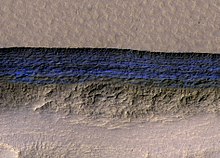Glaciers on Mars
Glaciers, loosely defined as patches of currently or recently flowing ice, are thought to be present across large but restricted areas of the modern Martian surface, and are inferred to have been more widely distributed at times in the past.
[10] A variety of surface textures seen in imagery of the midlatitudes and polar regions are also thought to be linked to sublimation of glacial ice.
[2] Based on current models of the Martian atmosphere, ice should not be stable if exposed at the surface in the mid-Martian latitudes.
[19] It is thus thought that most glaciers must be covered with a layer of rubble or dust preventing free transfer of water vapor from the subliming ice into the air.
[8][19][20] This also suggests that in the recent geological past, the climate of Mars must have been different in order to allow the glaciers to grow stably at these latitudes.
[27] However, recent direct observations made by the SHARAD radar instrument on the Mars Reconnaissance Orbiter satellite have confirmed that at least some features are relatively pure ice, and thus, true glaciers.
[6][8] Some authors have also made claims that glaciers of solid carbon dioxide have formed on Mars under certain rare conditions.
[36][37][38] It is thought that ice accumulated when Mars' orbital tilt was very different from the present (the axis the planet spins on has considerable "wobble," meaning its angle changes over time).
[44] Furthermore, at this high tilt, stores of solid carbon dioxide (dry ice) sublimate, thereby increasing the atmospheric pressure.
[43] When the tilt begins to return to lower values, the ice sublimates (turns directly to a gas) and leaves behind a lag of dust.
[47][48] The lag deposit caps the underlying material so with each cycle of high tilt levels, some ice-rich mantle remains behind.
When opposing lobate debris aprons converge, linear valley fill results [64] Many of these features are found in the Northern hemisphere in parts of a boundary called the Martian dichotomy.
Mars has vast glaciers hidden under a layer of rocky debris over wide areas in the mid-latitudes.
These glaciers could be large reservoir of life-supporting water on the planet for simple life forms and for future colonists.
[84] Research by John Holt, of the University of Texas at Austin, and others found that one of the features examined is three times larger than the city of Los Angeles and up to 800 m thick, and there are many more.

